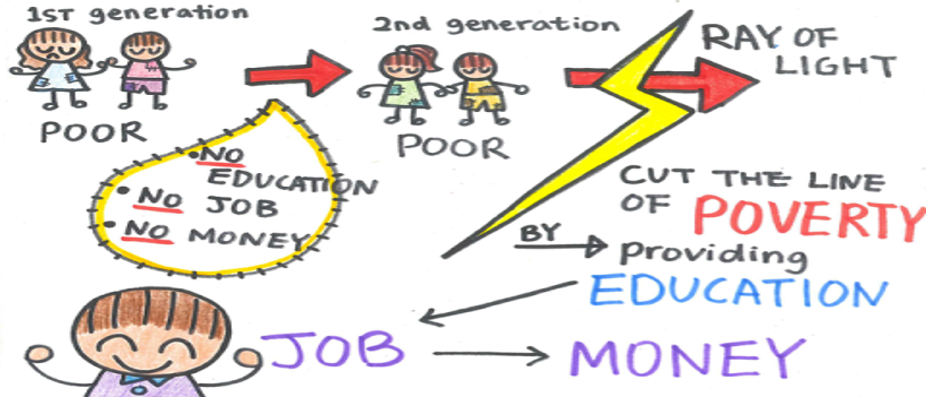When a child is born in a very poor family, they enter different phases of a very long cycle of poverty that can run for many generations. The covid-19 pandemic that has gripped the world by storm has brought many social issues to the forefront and by this raising questions as to how to break the poverty cycle. The self-realization is that education is the key to get out of this trap since families that live in poverty have very limited access to resources.
Benefits From Education:
- Safety and Support
Schools are usually considered a safe place to be, and which can also be used for recreational activities for families. By having this infrastructure, children are being able to be supervised by adults while their parents are working. A very strong community school provides support to families during a crisis since they are welcome there. This prevents them from being vulnerable to abuse, illness, or injuries.
- Future Employment Opportunities
The more skill set mastered by children such as higher comprehension and problem-solving skills in a shorter period ensures that family and future generations can and will be able to break the cycle of poverty. When children have the access to better paying jobs, they can have better lifestyles.
- Creation of a Culture of Education
There is a high probability that children that are educated will pass on the knowledge to their children. Their children would be exposed to learning from a very young age. Education will become part of their family culture. In comparison to poor households, school attendance is not a priority since everyday survival is the main goal.
Poverty in Belgium
There are various factors that can influence the risk of poverty in children. These include:
- the family configuration (for example single parent families)
- the employment status of the parents
- children with migrant backgrounds
- the educational level of the parents
In 2014, the poverty risk for children between the ages of 1 and 17 was 18,8 % compared to only 15,5 % for the Belgian population in general. The poverty risk for children in 2008 was still 17,2 % (Interfederal poverty barometer, 2014). [3]
For the year 2020, 14.1% of the population was considered at risk of monetary poverty (AROP) in Belgium. These are people living below the poverty line since their disposable income amounts to 1,284 euros monthly for a single person. 11.9% of the population were living in a household with low work intensity (LWI). And 3.9% of the Belgian population was facing severe material deprivation (SMD). [3]
According to the European poverty indicator, which was used in the Europe 2020 strategy, the people that fall into one or more of these situations stand the risk of social exclusion. In comparison with the regions in the European Union, 14 countries perform better than Belgium in relation to the poverty risk for children from ages 17. Also, the poverty risk among the young children ages 0 to 5 years is lower in 18 European countries compared to Belgium.
Education in Belgium
In Belgium, most of the educational institutions offer very low-cost tuitions or grants to students. However other costs such as books and other resources are not free. To find a good job in Belgium, a very good level of education along with hard and soft skills are required. About 77% of adults aged 25-64 have completed their upper secondary education. Regarding gender, 78% of women have completed high school in comparison to men at 76%. [2]
This is an indication that Belgium has successfully delivered quality education to all regardless of gender. According to the OECD’s Programme for International Student Assessment (PISA), the average student scored 503 in reading literacy, maths, and science. This is higher than the OECD average of 486. Also, generally girls had better average scores in most of the OECD countries except for Belgium where the boys recorded 1 point higher than the girls. [2]
The Belgian Solution- a shared challenge
There have been many strategies put forward to eliminate poverty in children. With the complexity of the Belgian institutional model, which is made up of regions and communities that have their own governments, it has proven to be a challenge in the implementation of policies. However, over the decades, there are two policy measures that have been developed. These include:
- The national child poverty reduction plan
- The federal measure for the support of local consultation platforms for the prevention and detection of child poverty
The first plan focuses on fighting poverty as part of the Europe 2020 strategy.
The second plan focuses was developed based on the European Recommendation ‘Investing in children: breaking the cycle of disadvantage’. These plans hope to achieve the following:
(1) access to adequate resources,
(2) access to quality services
(3) opportunities for and active participation of children in society.
In Belgium for example, the Teach for Belgium programme which is supported by Semlex for Education , is a non-profit organization that advocates equal opportunities for success for all students regardless of their socio-economic background.
If there are other projects that you would like to share with us, please do not hesitate to contact us!
Written by Bhoomattee Surujdin for Semlex for Education.
Resources
[1] Ismal, Moyeenul- How Does Education Help Children Break The Cycle of Poverty?-Right to Learn Foundation, copyright 2021. [2] OECD Better Life Index- Belgium Retrieved from https://www.oecdbetterlifeindex.org/countries/belgium/ [3] DE MEYER Magda,et al- Poverty and social exclusion in childhood-Early intervention and prevention: the situation in Belgium-2016

